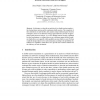Free Online Productivity Tools
i2Speak
i2Symbol
i2OCR
iTex2Img
iWeb2Print
iWeb2Shot
i2Type
iPdf2Split
iPdf2Merge
i2Bopomofo
i2Arabic
i2Style
i2Image
i2PDF
iLatex2Rtf
Sci2ools
AMEC
2004
Springer
2004
Springer
An Evolutionary Game-Theoretic Comparison of Two Double-Auction Market Designs
In this paper we describe an analysis of two double auction markets— the clearing house auction and the continuous double auction. The complexity of these institutions is such that they defy analysis using traditional game-theoretic techniques, and so we use heuristic-strategy approximation to provide an approximated game-theoretic analysis. As well as finding heuristic-strategy equilibria for these mechanisms, we subject them to an evolutionary game-theoretic analysis which allows us to quantify which equilibria are more likely to occur. We then weight the design objectives for each mechanism according to the probability distribution over equilibria, which allows us to provide more realistic estimates for the efficiency of each mechanism.
AMEC 2004 | Double Auction | Game-theoretic Analysis | Information Management | Traditional Game-theoretic Techniques |
| Added | 30 Jun 2010 |
| Updated | 30 Jun 2010 |
| Type | Conference |
| Year | 2004 |
| Where | AMEC |
| Authors | Steve Phelps, Simon Parsons, Peter McBurney |
Comments (0)

